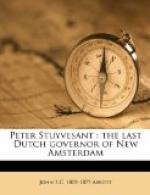At this time, 1652, there were no settlements, and but a few scattered farmhouses between the island of Manhattan and the Catskill mountains. Thomas Chambers had a farm at what is now Troy. With a few neighbors he moved down the river to “some exceedingly beautiful lands,” and began the settlement of the present county of Ulster.
Stuyvesant returning to Manhattan, forbade any persons from buying lands of the Indians without his permission. The large sales which had been made to prominent individuals were declared to be void, and the “pretended proprietors,” were ordered to return the purchase money. Should they however petition the governor, they might retain such tracts as he and his council should permit.
By grant of the governor several new settlements were commenced on Long Island, one at Newton, one at Flatbush. The news had now reached the Directors of the Company in Holland, of the governor’s very energetic measures on the Delaware, supplanting the Swiss, demolishing fort Nassau and erecting fort Casimir. They became alarmed lest such violent measures might embroil them with the Swedish government. In a letter addressed to Stuyvesant, they wrote:
“Your journey to the South river, and what has passed there between you and the Swedes, was very unexpected to us, as you did not give us before so much as a hint of your intention. We cannot give our opinion upon it until we have heard the complaints of the Swedish governor to his queen, and have ascertained how these have been received at her court. We hope that our arguments, to prove that we were the first possessors of that country, will be acknowledged as sufficient. Time will instruct us of the design of the new-built fort Casimir. We are at a loss to conjecture for what reason it has received this name. You ought to be on your guard that it be well secured, so that it cannot be surprised.”
The States-General were more and more dissatisfied with the measures of Governor Stuyvesant. The treaty of Hartford was severely censured. They said that the Connecticut river should have been the eastern boundary of New Netherland, and that the whole of Long Island should have been retained. Even the West India Company became convinced that it was necessary to make some concessions to the commonalty at Manhattan. They therefore communicated to Stuyvesant their consent that the “burgher government” should be established, which the committee of Nine had petitioned for in behalf of the commonalty, in 1649, and which the States-General had authorized in 1650.
By this arrangement the people were to elect seven representatives, who were to form a municipal court of justice, subject to the right of appeal to the Supreme Court of the province. The sheriff was also invested with new powers. He was to convoke and preside at the municipal court, to prosecute all offenders against the laws, and to take care that all the judgments of the court should be executed. The people at Manhattan had thus won, to a very considerable degree, the popular government which they had so long desired.




